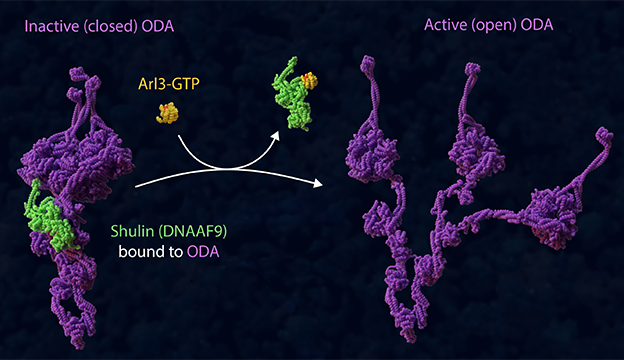Switching on dynein motors to power cilia motion
 Cilia are vital for human health, driving fluid movement in the airways, brain, and the reproductive system. Defective ciliary beating underlies devastating human diseases called motile ciliopathies. Ciliary movement relies on outer dynein arms (ODAs) which are powerful motor protein complexes. ODAs exert forces on ciliary microtubules to generate beating motion. ODAs must be carefully regulated to prevent premature activity as this can severely disrupt the cells’ microtubule organisation.
Cilia are vital for human health, driving fluid movement in the airways, brain, and the reproductive system. Defective ciliary beating underlies devastating human diseases called motile ciliopathies. Ciliary movement relies on outer dynein arms (ODAs) which are powerful motor protein complexes. ODAs exert forces on ciliary microtubules to generate beating motion. ODAs must be carefully regulated to prevent premature activity as this can severely disrupt the cells’ microtubule organisation.
In their inactive state, ODAs are packaged in the cell by an inhibitory protein called Shulin (known as DNAAF9 in mammals; green molecule in the figure). Shulin keeps ODAs “switched off” during their assembly and transport to the cilia. Once ODAs reach cilia, they must be activated i.e. Shulin must be released. This study reveals how the GTP-bound form of ARL3, an essential ciliary GTPase protein, binds to Shulin and displaces it from ODAs, unlocking the motors specifically inside cilia. This release allows ODAs to become active and power ciliary movement.
Using a combination of biochemical reconstitution, mutagenesis, and structural analyses, the group identified the binding region between ARL3 and DNAAF9. This work presents a unified model for ciliary dynein regulation – ODAs are assembled and kept inactive in the cytoplasm, transported into cilia via intraflagellar transport (IFT), and locally activated by ARL3-GTP within cilia to power motility.
The study uncovers a fine-tuned molecular switch in motor activity that is coupled to the GTPase cycle of an essential ciliary protein, marking a significant step in our understanding of how motor proteins are spatially and temporally controlled. For their breakthrough work, the research team, led by Dr. Girish Ram Mali with support from the studies first author Dr. Karim Housseini, received the 2025 Ian and Barbara Gibbons Award (named after the pioneers who discovered the dynein protein).
Article drafted by Siham Abdul Jaleel and edited by Girish Ram Mali.
Artwork and molecular animation by Matthew Clark.
Read the Paper
Issa, K.H.B., Ren, M., Burnet, B., Lu, H., Melia,C., Heesom, K., Roberts, A.J. Roy, S. & Mali, G.R. Molecular basis for the activation of outer dynein arms in cilia. Nat. Struct. Biol. (2025). https://doi.org/10.1038/s41594-025-01680-9
Mali Group
Investigating how cells assemble axonemal dyneins, large multi-subunit motor proteins that power the rhythmic beating motion of eukaryotic cilia and flagella.
More news
The latest news stories and research highlights from the Dunn School.